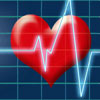Healing The Heart Naturally ~ Part II
 by Marsh Morrison, D.C., Ph.C., F.I.C.C.
by Marsh Morrison, D.C., Ph.C., F.I.C.C.
All of us know that we are creatures of habit. What is not so well understood is that we are just as much creatures of good habits as of bad ones.
Getting used to a good habit, such as eating foods that are physiologically acceptable and therapeutically good for the heart, can stick with you all the remaining days and years of your life.
Beginning right now, we launch ourselves into becoming slaves of good habits—like the habit of consuming plentifully of what is good for the heart—just as we became victims of bad habits in the past.
Of chief importance as a healing food for the heart is wheat germ. It is plentiful, it is cheap, it is one of the best protein items of nutrition available on this planet. Most protein foods are expensive: note the cost tickets attached to steaks, fresh fish, processed cheeses. Yet wheat germ, which is far more beneficial a protein foodstuff for weak and ailing hearts than any of the others, is as inexpensive as any reasonable person might desire. A full pound of it sells for under a dollar, and a pound supplies nutrition of the finest kind for many days.
There are other good protein foods, as we shall see ahead. But wheat germ is not only the best protein as a protein; as a miracle longevity food for the heart, it leads all others by a wide margin. The other “heart foods,” as we shall soon learn, are excellent sources of nutrition, while secondary as heart-healing foods. Wheat germ ranks almost alone because of the sound physiological reason that it is, in a very real sense, a specific for the heart. Thus it is the best of the good ones.
THE MAGIC OF WHEAT GERM
What is there about this food that makes it so specifically healing food for the heart? Here we must understand what usually happens in a stricken heart and what there is in wheat germ to alleviate or overcome the trouble. I refer to an ingredient known technically as d-alpha tocopherol. This is a fine inner ingredient of wheat germ, a part of the vitamin E factor within wheat germ.
Medically, a heart patient suffering from coronary artery disease or other cardiac problems is given daily a blood-thinning drug. This is needed because the heart patient’s blood tends to clot and interfere with the flow of blood nutrition to the heart. The drug is taken specifically to prevent clotting and thus keep the supply lines of blood to the heart muscle open and unimpeded.
In wheat germ, it is the d-alpha portion that keeps human blood thinned down naturally, safely, effectively. A small daily cereal bowl of wheat term with skim milk is beautifully protective for cardiac victims, and without an iota of side effects ever, at any time. This is because the d-alpha content of wheat germ is the body’s natural anti-clotting substance.
Medical legend has it that the principal cause of death in America is coronary artery disease, commonly called coronary occlusion. In my own research projects done on an independent level, not indebted to the American Medical Association or medical societies or pharmaceutical interests, I have come up with findings and answers to dispute this, but that is a matter to be taken up elsewhere. For now, suffice to say that coronary occlusion is an arterial problem wherein the vessels that convey blood to the heart (usually two of them, sometimes three) become occluded or clotted with plaques. These plaques constitute a kind of sludge somewhat the consistency of toothpaste, and they hang onto the inner walls of the arteries, thus making the arterial passageway smaller. If you have ever seen a water pipe encrusted with lime or other debris that narrows the inside area of the pipe, you can imagine a coronary artery with much the same situation.
My own displeasure with medical anti-coagulant drugs prescribed by medical doctors in heart cases is that they produce side effects as do all drugs, including aspirin and other common medicines that American people have come to take unthinkingly just as though they were popping peanuts into the mouth. You must understand clearly what side effects really mean, for they are unutterably serious and have caused a pileup of diseases in the land beyond calculation.
Side effects are effects in the body besides what the body suffered before taking the drugs. Side effects are effects within the system in addition to the maladies already existing. As one writer put it, “A drug with side effects, and hardly any are without side effects, leaves two diseases in the body where but a single disease existed before.” So you can understand why this author feels so keenly enthusiastic about a food such as wheat germ that is not only a first rate miracle longevity food for the heart, but does not have even the faintest scintilla of side effects.
Drugs have the habit of building physiological and pathological troubles in the human organism—one of those bad habits I mentioned. Many diseases that plague the nation today have come to be called iatrogenic (physician-caused) ailments. A favorite medicine taken by millions to suppress the symptoms of a cold is one I strike out against with some fury exactly because it does that: it suppresses what ought to be sneezed or coughed or sweated out of the body, leaving the poisons to be accumulated and build new disease with the system. But none of this occurs with wheat germ, the purest kind of food which is also an anti-coagulant without being a drug.
In this imperfect world there are not too many items of nutrition with natural healing ingredients built into the food. If you will remember that there are no side effects from a food, but only from a drug, and that wheat germ has this drug-like anti-clotting and heart-helping quality as a natural built-in ingredient, then, since you now understand what side effects truly mean, you will favor wheat germ with an enthusiasm that equals my own.
There are other foods that I have found specifically good for the heart. While wheat germ is the one I consider most important for extending life through improved cardiovascular function, one cannot forever eat just wheat germ. To know the other “heart helpers” is to have good handy armamentarium at hand. Before going into these other good heart fuel foods, and just how to prepare and combine all the heart healing food items into palatable dishes, I must tell you the case of little Gregory.
Here is a chubby boy of almost 11 who had a sad history of rheumatic heart disease. He weighed 80 pounds, had very little immunity or resistance against infections because of a suspected thymus dysfunction, suffered from labored breathing and could not play with other boys since a bout with rheumatic fever four years earlier. The parents were wealthy and took Greg around unstintingly to what they denominated “the best cardiologists,” but still the boy wheezed and was listless and over ate, while almost wholly inactive.
Fortunately, he liked a large cereal dish at breakfast. There I could employ wheat germ advantageously, but in small meals because my researches had established beyond doubt that cardiac patients needed a few small meals rather than three heaping “squares” a day. Also, I found the cardiologists’ exercise program for the boy quite wrong. I put the boy on two bathroom scales with his little feet equidistantly apart, one foot on each, and instead of his weighing 40 pounds on each scale he was 32 pounds on one side and 48 on the other, a fact that showed he was exhaustingly offside and had to use up his strength to fight staying in balance like a car that had been in a collision and dragged offside as one drove it.
I explained to Greg’s father and mother two matters of great importance. One, that he was structurally out of alignment and no machine that was out of balanced adjustment could reasonably be expected to function normally. Two, that while his heart doctor was right in recommending an exercise program for the boy, it was just exactly wrong to do any physical drills standing and sitting straight up in defiance of gravity when the heart was already weak and should not be required to pump more blood faster to the child’s distal extremities straight uphill. They understood at once the wisdom of slowly building strength into the heart muscle through exercises, but exercises done on the floor or bed while the heart was on the same level as the body and could pump out the blood accelerated through exercise without hurtful strain. Also they understood that the potential value of any food is not its actual value—and this needs a bit of explaining.
Even the best foods, those of great potential usefulness, first must be appropriated by the body, absorbed and metabolized and utilized before their potential values to the body become actual values. If there are misalignments that prevent the flow of vital life forces to the digestive apparatus, for example, proper conversion cannot take place because along with the mechanical misalignments there are nerve pressures which prevent the free flow of life force to the digestive organs. This explains why some sick folk always buy the most natural and health promising foods in expensive health food stores and forever remain sick. It is because they are out of mechanical adjustment usually. They have interfering pressures on nerve pathways that must deliver power and direction to their digestive apparatus. Lacking such power, even the potentially best foods fail to become converted and utilized, remaining potentially valuable rather than actually valuable to the ailing body.
Here is a lesson I shall repeat many times with reference to healing foods for other organs and other ailments: namely, that to ensure the best use and utilization of amazing healing foods the body must at the same time be in somewhat correct alignment, not in a state of maladjustment. I never tire of getting this truth across in all my writing: a machine such as a human body, which is made up of many movable mechanical parts, when out of mechanical adjustment cannot work right until put back into a mechanically aligned state.
I explained to Greg’s parents the value of wheat germ. I emphasized that the grain must be fresh, for rancid wheat germ, as with all grains, can even cause stomach cancer. The way to avoid rancidity is merely to smell the container before taking out the wheat germ; if it’s rancid your nose will tell you at once.
To put the child’s body into a mechanically correct state so that it could assimilate all the health giving value of wheat germ, I laid out a proper exercise program that was fun for the boy.
First, he was amazed that he weighed 16 pounds more on his left side than this right. I told him to race on his hands and knees on the lawn of his house, to do it without shoes so that his bare feet could contact Mother Earth, and to do it mornings when there might be dew on the grass. Fortunately, his family had an estate-like place where he could race on hands and knees on their grassy knolls. I explained to Greg that only human beings insulate themselves from the fine emanations of the earth with shoes, and he nodded understandingly. Then I had a dialogue with the 11-year-old.
BECOME A DEPUTY DOCTOR
“You know what a deputy sheriff is, don’t you, Greg?” I asked. Of course he did from seeing all those Westerns. “Well, I want you to become a deputy doctor,” I added.
His job was simple and he was enthusiastic. Every morning he was to stand on the two simple bathroom scales and write down his weight on both sides. Then he was to put on his knees the foam rubber pads his mother had cut out for him and race on hands and knees on the lawn until somewhat tired. Finally, he was to recheck his weight on the scales and determine if his racing across the lawn changed anything; that is, whether it brought him more nearly into mechanical balance or possibly even widened the difference in his left and right side weights.
“One thing more, Gregory,” I said. “In the cool of the evening each day I want you to ride your bike until you get a little tired, then check your weight on the two scales and write down, as an assistant research doctor should, if the bike riding or the hands-and-knees races make more of a difference in your lopsidedness.”
He agreed avidly, smiling broadly and importantly. I had in mind changing to other activities if these two did not help put his small, but chubby body back into adjustment.
As it happened, along with the amazing healing foods I recommended, everything came right and he needed no further exercise program. The lad had a daily schedule in which he importantly participated, and he grew slimmer and firmer. His constant tiredness was replaced by an enthusiasm for activity in only a few weeks. He no longer became victim to every infection in the area and a workup, including a thymus test, showed improvement in the gland. Most noticeable of all, he no longer wheezed and his breathing was not a labored, difficult function. The latter was achieved by a bedtime diaphragmatic exercise I gave him to re-oxygenate the system before he went to sleep. It consisted merely of raising his arms and panting like a dog, moving the great breathing muscle, the diaphragm, in and out as he panted, thus strengthening his chief organ of the breathing mechanism. The diaphragm, like all muscles, grows stronger with use and this in-and-out bedtime drill strengthened Gregory’s breathing function in short order while at the same time oxygenating his little body for a good night’s sleep.
Now—specifically–what were the miracle foods that did the job? Besides wheat germ I recommended a daily helping of the following secondary healing foods for the heart: blackstrap molasses, brown rice, raw pecan nuts, lecithin flakes (or liquid lecithin if tolerated), rice water as a daily drink in place of junk food soda pops, bioflavonoids, either sunflower seeds or pumpkin seeds as a daily protein, and one egg every day, especially the yolk. And as in all cases, about 600 units of vitamin E every day.
The foregoing were daily items, more or less. Other secondary heart-healing items (secondary only to wheat germ, remember), could be taken every second or third day. These included yogurt, raw garlic, brewer’s yeast, watermelon and whole wheat toast, the latter spread with blackstrap molasses.
Now follows the real crux of this: that is, why—for what reason—are each of the aforementioned foods specifically heart-healing and generally health improving items of nutrition? This is the part you will remember, the part that will help you and your loved ones into natural health without resorting to drugs and their nasty, disease-making side effects.
First, however, a short paragraph as to why Gregory was so much offside as to weigh 32 pounds on one half of his little body and 48 on the other half. On inquiring and boring into the case history I extracted from his parents something they hadn’t considered causative at all. At age seven, the child had gone on an old fashioned hay ride in the country and Greg had fallen off the wagon onto the hard gravel road when the wagon jolted and the boy he was scuffling with on the wagon let go. Greg complained of a bruised hip and the family medical doctor gave him a pain pill plus an injection into the buttock, just as though that could put back into adjustment the misalignment that the jarring fall had caused. In all my years as a doctor I have never seen a heart case of any kind that did not reveal upon careful examination an associated mechanical distortion that produced nerve pressures, which in turn robbed the heart muscle of its “working juice”–a free flow of nerve impulses. The conversation with Gregory’s parents adduced the revealing information that soon after the fall from the hay wagon came the rheumatic fever that resulted in his having a rheumatic heart.
In this frame of reference, there was the elderly Mrs. Lawrence with her cardiac arrhythmia that always frightened her to death, making her think the next breath would be her last. In her case also there was a bodily jolt that preceded the heart trouble. While walking leisurely on the sidewalk, a teenaged lad on a bicycle came careening along and knocked the lady down, sending her sprawling on her face with a jolt that lacerated her elbows and broke her glasses. Soon after this she awoke with a pounding heart, then missing beats and an identifiable lack of rhythm in her heart sounds, all this not responding to the drugs prescribed by her medical man and getting worse until I saw her.
Near Mrs. Lawrence’s home there were two streets on different levels connected by a steep line of stone steps, and she was told to do several daily turns at mounting and dismounting these steps while also taking long walks for her bulging varicose veins. Along with the foods I recommended for her heart, those I am about to explain in the following paragraphs, this elderly lady of 62 not only lost her distressing cardiac symptoms, but also the cosmetically annoying knots in her legs.
In first place, next to wheat germ, I must place lecithin because it also is a heart-feeding item that is at the same time a longevity food, one that tends to ensure a free and unobstructed flow of blood to the heart through unclotted coronary vessels.
What is most arresting about lecithin is that it is just as much a brain food of primary importance as it is a food for the entire cardiovascular system. You should be informed that almost one-fifth of your brain is made up of lecithin. It is a constituent of every cell and bone and organ and gland of your body. Here is an item of food that is almost as useful for extending brain health as heart health.
WHAT LECITHIN DOES
What lecithin does is this: in a graphic sense that is also scientifically valid, it rinses away the cholesterol deposits and plaques that block the coronary arteries and prevent a free flow of that blood to the heart which the heart muscle itself must have for its pumping action. In a mysterious way not fully understood, lecithin works at dissolving the arterial deposits that interfere with a good, rich, oxygenated blood reaching the heart. In the brain, by dissolving the clotting plaques, lecithin makes it possible for a freer flow of blood that at once improves mental work, memory, and general cerebral function.
Happily, many ordinary supermarkets carry lecithin flakes these days. In the case of the little boy Greg, with rheumatic heart disease, I advised adding about three tablespoonfuls of lecithin flakes to his morning bowl of raw wheat germ and skim milk. When the cereal was also flavored with one tablespoonful of blackstrap molasses it constituted a powerful array of heart-fuel items that beat anything in pharmacology that I know about. But for a disciplined grown person who really desires fast results I recommend lecithin in its liquid form, available at health food stores. I say a “disciplined” person because lecithin has a somewhat disagreeable way of sticking to the roof of the mouth that children and many fussy oldsters cannot abide. In my own lifestyle I take a large spoonful of liquid lecithin every day at bedtime, missing only when away from home on a lecture tour.
THE WONDERS OF BLACKSTRAP MOLASSES
Reviewing blackstrap molasses is agreeable work, for this wonder item of nutrition is exceedingly rich in potassium, among other goodies, and potassium extends life by giving life to a weak heart. I ask cardiac patients to remember this point; foods with a rich potassium content are good for the heart—and foods high in sodium are bad for the heart, as witness table salt.
In addition to heart cases, diabetics ought to be told that blackstrap molasses contains almost no sugar whatever. Since sugar is one of our society’s principal causes of heart strain, this is utterly important.
In both the cases of little Gregory and elderly Mrs. Lawrence I used these three great mainstay heart-feeding foods: wheat germ, lecithin flakes, blackstrap molasses. In the lady’s case I advised a tablespoonful of liquid lecithin at bedtime in addition to the three spoonfuls of lecithin flakes with the morning cereal, which speeded results enormously.
Bentley was a retired gentleman of 66 formerly tense, nerve strained, many years in competitive banking, now suffering from cardiac hypertrophy—an enlarged heart. This resulted, in my opinion, from overextending in college athletics (on wrestling team), later aggravated by business tensions and insufficient physical activity. One cardiologist had recommended surgery on Bentley’s vagus nerve, the chief nerve supply, sometimes named the pneumogastric, to the heart.
The man’s face was flushed when he came to me. He suffered frequent headaches. When I took his pulse I found it bounding, jumping, very strong. Questioning elicited that he had an annoying ringing in the ears—all of it confirming that Bentley had what used to be called “an athletic heart,” or in common terms, an enlarged heart that took up more than its share of space in the chest. I tested the other major nerve supply just back of his collarbones and these, the phrenic nerves, also bounded and gave signals of palpitation.
Bentley was not stout, but rather trim and neat with a flat abdomen and a well-developed chest that spoke of former athletic prowess. I knew that his vagus nerve should not be cut or in any way disturbed, but what he needed was a very graduated program of exercises, mild at first and working up to where the heart could compensate for its inactivity. Also he needed a succession of very small meals, say, one every two hours.
For all its seeming difficulty this was an easy case, really. The man was happy to have a well-defined, serious program. He got on his back and rode an imaginary bicycle upside down with increasing speed every day. His frequent (and small) meals were: four tablespoons of wheat germ and a little skim milk in the morning. Two hours later, four ounces of plain yogurt into which he stirred a tablespoon of blackstrap molasses. At the next meal he chewed a dozen raw and unsalted pecan nuts. Then, with each succeeding meal, a small portion of raw and steamed vegetables taking only one kind at a time.
One month later Bentley walked a half mile. In six weeks he went a whole mile at a good clip and his pulse was neither bounding nor irregular. At the end of the second month this seriously sick man was a wholly well man; his heart sounds quite normal and heart size satisfactorily reduced. A suspicious valvular insufficiency had also disappeared. With those amazing healing foods and a health-promoting program, this otherwise problem case responded into health without incidence.
Sylvia was at age 55 a very old woman because of an inflammatory condition of both the muscle tissue of her heart and the lining membrane of the inside heart surface, including the cavities or chambers. When I touched the area over her heart it was very tender—one sign of carditis, as the condition is called. Her pulse was weak and very rapid. When she went to an altitude of about 5,000 feet she suffered grievously, so she could not accompany her family to their mountain retreat. If hurried the least bit, Sylvia just gave out; she could not abide haste in any form. In their commodious home they had to design a downstairs bedroom for the lady of the house, for climbing the staircase was impossible.
Years ago I had learned that in nearly all cardiac cases there was an associated digestive or eliminative problem. In Sylvia’s case, the trouble was stubborn constipation.
Along with the amazing healing foods for the heart listed at the end of this article (coming in Part IV), I instructed the lady in the use of high fiber foods. She had whole wheat germ, lecithin flakes, a mixture of grape nuts and mouth-sized shredded wheat along with daily leafy vegetables and fresh fruits, all of them supplying roughage for the lady’s sluggish bowels. When I added psyllium seeds during the first few days of treatment—just a tablespoon of the seeds in eight ounces of any kind of fruit juice taken twice a day—she began passing copious stools and this at once took some strain off her heart.
I started a careful program of very light exercises along with the healing foods. In less than two weeks Sylvia reported something quite strange. “I needed my sewing kit upstairs,” she said, “and went to get it without realizing that I was actually climbing those long stairs until I got to my old bedroom—something I had not done in two years.”
Sylvia’s improvement was excitingly rapid. She made it a daily habit to go upstairs once or twice a day, just for the exercise. She took long walks in bare feet on her spacious, grassy lawn. By the time she celebrated her next birthday (her 56th) some two and a half months later, she was, in her words, “not an old woman but truly young again.” Her husband, Karl, said to me that he and all the family expected nothing but a decline into death, certainly not this stamp of renewed health in only ten weeks.
Excerpt from Doctor Morrison’s Amazing Healing Foods
Posted in Health, Other Topicswith comments disabled.





